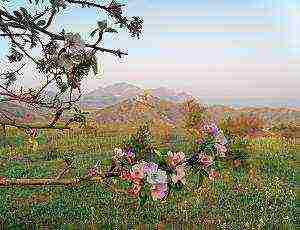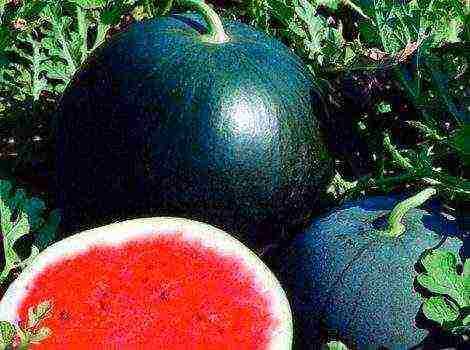Content
- 1 1. Bluegold
- 2 2. Bluecrop
- 3 3. Blurey
- 4 4. Bonus
- 5 5. Herbert
- 6 6. Jersey
- 7 7. Duke
- 8 8. Northland
- 9 9. Patriot
- 10 10. Elizabeth
- 11 Varieties of garden tall blueberry
- 12 Description of varieties of undersized blueberry
- 13 The best blueberry varieties for the Moscow region: Erliblu, Nelson, Spartan and others
- 14 Northern varieties of American tall blueberries
- 15 Domestic varieties of garden blueberries for cultivation in Siberia and the Urals
- 16 Garden blueberry care
- 17 Fertilizing blueberries to increase yields
- 18 Review of popular brands of fertilizers that increase blueberry yields
- 19 Frequently asked questions when growing blueberries
- 20 Common mistakes when choosing blueberry varieties
- 21 Blueberries - tasty and healthy
- 22 Blueberry varieties
- 23 Planting and leaving
Tall blueberry, or garden blueberry, is a beautiful and healthy plant. By planting bushes of one of these 10 varieties around the perimeter of the garden, you will get a charming hedge that every summer will delight you with a rich harvest of delicious and very healthy berries.
Gardeners began to cultivate wild blueberries only 100 years ago, so we can safely say that garden blueberries are a young culture. This berry is attractive both as an ornamental plant and as a berry shrub, which gives a high-quality, tasty, vitamin-rich harvest.
If for some reason you still have not managed to "settle" tall blueberries in your garden, we advise you to try one of these varieties.
1. Bluegold
This popular blueberry variety is light blue with a dense, aromatic flesh. And the bushes themselves are lush and beautiful, so they will be a wonderful decoration for any garden. However, it should be borne in mind that spreading is at the same time a lack of bushes of this variety, because they require strong pruning.
Bluegold is an early variety. The fruits acquire a rich color at the beginning of summer and ripen amicably by mid-July. From one bush, from 4.5 kg of berries are harvested, even in not the most productive years.
This blueberry can withstand frosts down to -35 ° C, therefore it is suitable for growing in northern regions. The weak side of the variety is that its berries wilt quickly, mummify, especially if the summer is hot.
Bluegold berries crumble when overripe, so it is important to harvest on time!
| Maturation | Bush height (m) | Berry diameter (mm) | Productivity (kg per bush) | Peculiarities |
| Mid july | 1,2-1,5 | 16-18 | 4,5-7 | High frost resistance |
2. Bluecrop
This mid-season American blueberry was developed over half a century ago. Berries are light blue, large with firm pulp. They can be easily identified by their characteristic flattened shape.
It is worth planting several Bluecrop bushes on your site because the plants of this variety are not afraid of snow, or heat, or pests and viruses, and the fruits themselves do not crack when overripe, withstand transportation with dignity, are well stored and do not lose their rich taste when frozen.
| Maturation | Bush height (m) | Berry diameter (mm) | Productivity (kg per bush) | Peculiarities |
| End of July - August |
1,6-1,9 | 17-20 | 6-9 |
Disease resistance, |
3. Blurey
What gardener does not dream of a shrub that will delight with lush flowering in spring, excellent harvest in summer and fabulously beautiful fiery foliage in autumn? If you were looking for such a plant, consider that you have already found it! Blueberries of the Blurey variety don a romantic pink dress in the spring, and change it to a fiery red dress in the fall.
The berries are juicy, very sweet, shiny, deep blue in color. The bushes are literally strewn with them, tk.Blurey gives not just a bountiful, but an excessive harvest. However, excessive fruiting is at the same time a disadvantage of the variety, because it depletes the plant. When choosing blueberries of this variety for your garden, this feature should be taken into account.
The variety has one more strong side - it is very winter hardy. Blueberries Blurei can withstand frosts down to –34 ° С.
These berries are best eaten fresh. Moreover, they remain so for a long time and do not crack even when they are overripe.
| Maturation | Bush height (m) | Berry diameter (mm) | Productivity (kg per bush) | Peculiarities |
| End of july | 1,2-1,8 | 12-17 | 5-8 | Prone to excessive fruiting |
4. Bonus
If you see a coin-sized blueberry on the market, there is a 99.9% chance of it being a Bonus berry. Perhaps this is the largest-fruited tall blueberry that can be grown in your summer cottage.
The berries themselves are fragrant, dense, sweet. They are suitable both for fresh consumption and for freezing. This blueberry gives a good harvest and tolerates frosty winters with dignity. Isn't it a gardener's dream?
|
|
||||
| Maturation | Bush height (m) | Berry diameter (mm) | Productivity (kg per bush) | Peculiarities |
| July August | 1,5-1,6 | 20-30 | 5-8 | Good winter hardiness |
5. Herbert
Herbert blueberry is one of the best you can grow in your garden. This is in the full sense of the word a tall blueberry - the height of a bush can reach 2.2 m!
Of course, the fruits are not as gigantic as those of the Bonus, but they are still quite large - about 2 cm in diameter. They have a delicate taste, they do not crumble or crack when overripe.
The bushes of this variety multiply easily, winter well, give up to 9 kg of harvest per season and are unlikely to cause you much trouble.
| Maturation | Bush height (m) | Berry diameter (mm) | Productivity (kg per bush) | Peculiarities |
| Mid august | 1,8-2,2 | 20-22 | 5-9 | Reproduces easily |
6. Jersey
This is an old variety of tall blueberries, tested by thousands of gardeners. If you expect undemanding care and a stable harvest from a berry bush, even in not the most favorable years, you will definitely like Jersey.
Blueberries of this variety take root well on different types of soils, tolerate frosts well, and are resistant to diseases and viruses, in particular, to the red ring spot virus.
Jersey berries are small, light blue and round in shape. Due to their delicate sweet taste, they are perfect for processing: making homemade cakes, preserves, compotes. In addition, the blueberry harvest of this variety is well stored and suitable for freezing.
|
|
||||
| Maturation | Bush height (m) | Berry diameter (mm) | Productivity (kg per bush) | Peculiarities |
| Mid august | 1,6-2 | 15-16 | 4-6 | Virus resistant red donut blotches |
7. Duke
This variety is extremely popular in its homeland in America. And this is not surprising: the plants are resistant to frost, consistently give a high yield. Duke bushes are not afraid of spring frosts, because they bloom late, but they bear fruit quite early - already in mid-July.
The berries of this variety are "robust" with excellent taste and pleasant aroma. But keep in mind that during the ripening period, branches "loaded" with crops may break off, so it is advisable to tie them up.
| Maturation | Bush height (m) | Berry diameter (mm) | Productivity (kg per bush) | Peculiarities |
| Mid july | 1,2-1,8 | 17-20 | 6-8 | Not afraid spring frosts |
8. Northland
This variety is quite consistent with its name (translated from English "Northland" means "North Country") and is suitable for growing even in cold regions. American gardeners claim that Northland bushes can withstand frosts down to -40 ° C and consistently produce 4-8 kg of delicious berries.
The fruits of this blueberry are medium-sized, very sweet, so they are ideal for fresh consumption and for making jams and preserves.
The variety is resistant to pests and diseases, including the berry mummification virus. Northland bushes are "stocky", not tall.In the vicinity of other bushes of similar height, they can form a beautiful hedge on the site.
|
|
||||
| Maturation | Bush height (m) | Berry diameter (mm) | Productivity (kg per bush) | Peculiarities |
| Second half of July | 1-1,2 | 15-17 | 4-8 | Withstands frost down to -40 ° С |
9. Patriot
Bushes of this variety thrive in any type of soil, although heavy, well-moistened soils are most fond of. They also winter well, they are not afraid of late blight and stem cancer.
This variety has an interesting feature: in the process of ripening, the berries change color from green to red and only at full maturity acquire the usual dark blue color. The fruits ripen early - already in mid-July, they taste pleasant, sweet.
|
|
||||
| Maturation | Bush height (m) | Berry diameter (mm) | Productivity (kg per bush) | Peculiarities |
| Mid july | 1,2-1,8 | 17-19 | 4,5-7 | Resistant to late blight |
10. Elizabeth
Elizabeth blueberries are considered one of the leaders in taste and aroma. Her berries are large, firm, sweet - it is impossible to resist! The fruits do not ripen all at once, but within two weeks, so you will have the opportunity to "stretch" the pleasure. Please note that sometimes some of the berries do not have time to ripen.
The indisputable advantage of Elizabeth blueberries is the ease of reproduction (it is best propagated by lignified cuttings). But the variety has one feature - the plants do not develop well on sandy soil. Ideally, the soil should contain some peat.
The Elizabeth variety was named after an American woman. Elizabeth White, The "progenitor" of garden blueberries.
| Maturation | Bush height (m) | Berry diameter (mm) | Productivity (kg per bush) | Peculiarities |
| Early august | 1,6-1,8 | 14-17 | 4-6 | Fruiting is stretched by time |
From the whole variety of blueberry varieties, we have selected 10 of the most proven ones, which will certainly thank you for their excellent appearance and delicious harvest. I wonder which kind of garden blueberry will you choose?
Blueberries are a culture unfamiliar to Russian gardeners, the interest in which is increasing every year. It is a relatively thermophilic crop that requires careful selection of the variety.adapted to the climatic conditions of the landing region. This article provides an overview and description of the best blueberry varieties in different categories - Bluecrop, Thoreau, Duke, Spartan and others.
Table of contents
- Varieties of garden tall blueberry
- Early varieties: Reka, Duke, Patriot and others
- Late varieties: Bluecrop, Jersey, Bonus
- Description of varieties of undersized blueberry
- Early varieties: Northland, Bluegold, Northblue and others
- Mid-late varieties: Emil, Polaris, Putte
- Varieties of blueberry marsh
- The best blueberry varieties for the Moscow region: Erliblu, Nelson, Spartan and others
Varieties of garden tall blueberry
At the beginning of the 20th century, the Brucke variety was selected from the wild blueberry species. Subsequently the Russell variety was developed from undersized blueberries, which is distinguished by frost resistance and early maturity... After crossing these varieties, biologists obtained excellent results, and after adding southern blueberries to them, four valuable varieties were developed. So a new culture entered gardening - tall blueberries. Today there are about 50 registered varieties in the United States.
Tall blueberry - a branched shrub with a height of 1.2 to 2.5 m. The plant is distinguished by its rapid growth and good shoot-forming ability. The size of the fruits depends on the variety, often reaching up to 4 g. The taste of the berries is characteristic of the species, but sweeter than that of wild forms.
New varieties of tall blueberries are quite winter-hardy and frost-hardy, can withstand temperatures as low as -30 ° С... At lower temperatures, they can freeze, but with proper care they quickly recover. Spring frosts are more dangerous for loss of yield, blueberry flowers do not tolerate a temperature drop of more than -2 ° C.
Early varieties: Reka, Duke, Patriot and others
Fruits of early varieties of culture in the middle lane begin to ripen from the second half of July.
The best varieties:
- Rankocas;
- River;
- Sunrise;
- Puru;
- Duke;
- Patriot;
- Blues;
- Erliblu.
Extraordinary taste of fruits and high yield (8-18 kg per bush) differs grade River.
Duke grade very popular in America. Plant feature - late flowering, which excludes loss of yield due to damage to flowers by spring frosts. Despite this, the fruits ripen by mid-July. The shrubs of this variety have strong fruits with a dessert taste and a pronounced aroma.
Feature of the Patriot variety plasticity to soil conditions, resistance to late blight. Therefore, growing plants of this variety does not bring additional trouble to the gardener.
Many gardeners plant blueberry varieties with different ripening times in their garden. This allows for a continuous harvest from July to mid-September.
Late varieties: Bluecrop, Jersey, Bonus
Shrub fruits of these varieties begin to ripen in the first half of August.
The best varieties:
- Berkeley;
- Covill;
- Bluecrop;
- Hardible;
- Rubel;
- Bonus;
- Jersey;
- Toro;
- Darrow;
- Spartan;
- Elizabeth;
- Nelson.
Jersey variety one of the best pollinators, this should be taken into account when selecting shrubs for a combination planting. In addition, it is resistant to late spring frosts and viral diseases. This is an old and proven variety by many gardeners.
Bluecrop the most reliable, consistently fruiting variety. Productivity 6-9 kg per bush... The fruits of this shrub are valued for their high transportability and resistance to natural disasters. The Toro variety is highly frost-resistant, can withstand temperatures as low as -34 ° C.
A real find for lovers of eating fresh fruits is grade Bonus... This plant fruit diameter reaches up to 30 mm... The pulp is sweet and firm, so the fruit is able to withstand long-term transportation.
All varieties of tall blueberry presented in this review are suitable for cultivation in the southern and middle horticultural regions. When choosing a variety for a garden plot, it is important to pay attention to the characteristics of the plant, winter hardiness and disease resistance.
Description of varieties of undersized blueberry
The introduction of low-growing blueberry species into crops began in the 1930s, in parallel with tall species. The most promising forms were selected from wild species and breeding work was carried out. As a result varieties of undersized blueberry with a shorter growing season and higher frost resistance were bredthan varieties of tall crop species. Also, blueberry varieties obtained by selection from the natural population have been introduced into horticulture.
Depending on the variety, undersized blueberry shrubs reach a height of 50 cm to 1.2 m. The yield ranges from 1.2 to 2.5 kg, but there are exceptions. Medium-sized fruits from 1 to 1.8 cm in diameter with a pronounced sweet and sour taste, perfect for culinary preparations. The relatively high frost resistance makes it possible to successfully cultivate all varieties of undersized blueberries in the middle and northern regions of horticulture.
Early varieties: Northland, Bluegold, Northblue and others
Early blueberry varieties begin to ripen in mid-July.
Recommended varieties:
- Northland;
- Northky;
- St. Cloud;
- Northcountry;
- Bluegold;
- Northblue;
- Chippewa.
According to gardeners grade Northland can withstand downgrade temperatures up to -40 ° С... Therefore, it can be planted in regions with harsh winters. Plants of this variety are distinguished by a regular yield (4-8 kg per bush), which is rare for low-growing varieties.
St. Cloud the earliest variety, the fruits of the bush begin to ripen in early July. A distinctive feature is the need for annual pruning. Bluegold variety valued for its stable yield (4.5-7 kg per bush), winter hardiness and resistance to fungal diseases.
Mid-late varieties: Emil, Polaris, Putte
The fruits of these varieties begin to ripen from the beginning of August.
The best varieties:
- Emil;
- Polaris;
- Putte.
Feature of the Putte variety - self-fertility, it can be planted in single plantings.Polaris variety prized for consistent yields 1.5-2 kg from the bush. Fruits of the Emil variety sweeter, ideal for making preserves and jams.
All varieties of low-growing blueberries are compact and highly decorative, therefore they are often used in landscape design. Plants can be used to cover unsightly buildings, form a hedge, or decorate a spacious lawn.
Varieties of blueberry marsh
These varieties were introduced into cultivation by selecting promising forms of marsh blueberry. They are distinguished by high winter hardiness and frost resistance, they are recommended for cultivation in the Urals and Siberia. Blueberry bushes of these varieties able to withstand temperature drops from -35 ° С to -43 ° С.
Varieties:
- Taiga beauty;
- Marvelous;
- Shegarskaya;
- Blue scattering;
- Yurkovskaya;
- Graceful;
- Nectar.
Among these plants, gardeners highlight grade Taiga beautyable to withstand a drop in temperature down to -43 ° С... In addition, the variety is resistant to viral and fungal diseases. High yields are distinguished by varieties Divnaya and Golubaya scattering — 1.6 kg per bush... Have Shegarskaya varieties large (1.1 g) and juicy fruits.
The best blueberry varieties for the Moscow region: Erliblu, Nelson, Spartan and others
The climate in the Moscow region is moderately continental with a pronounced seasonality. The average temperature in winter is -11 ° С, during the influence of the anticyclone it can drop to -25 ° -30 ° С. The soil freezes up to 65-75 cm, and the height of the snow cover reaches 35-45 cm. Together, these conditions are suitable for growing blueberries. The only danger for blueberries is spring and autumn frosts, the possibility of which must be taken into account when choosing a variety and caring for it.
The best varieties:
- Patriot;
- Bluecorp;
- Rankocas;
- River;
- Bluegold;
- Blue Ray;
- Spartan;
- Puru;
- Erliblu;
- Nelson.
Variety Patriot actively cultivated by gardeners of the Moscow region. Among the positive characteristics, stable yield 5-7 kg per bush, resistance to root and stem rot. In addition, plants of this variety are highly decorative and are often used in the formation of hedges.
Rankocas variety an excellent option for early harvesting, the fruits of these shrubs begin to ripen in the first decade of July. The originators claim that the plants able to withstand frosts down to -34 ° С.
Fruits of the Spartan variety are an excellent option for fresh consumption. These are berries with light acidity, which keep their shape well and tolerate long-term storage. Erliblu variety is characterized by high winter hardiness, easily tolerates possible temperature changes and the influence of return frosts.
All varieties of undersized and marsh blueberries are suitable for growing in the Moscow region. They are less productive, but more plastic to climatic and soil conditions, are resistant to many diseases.
The basis for successful blueberry cultivation is the correct selection of the variety. This is a rather whimsical plant that requires careful adherence to all the rules of agricultural technology.... Despite this, many gardeners have already abandoned their usual berry crops, gradually equipping small blueberry plantations on their plots. This is facilitated by the high nutritional value of the fruits of the culture and the increased demand in the market.
Common blueberry has several other names among the people - drunk berry, dove, gonobel, titmouse and dove. This type of blueberry is widely cultivated in the temperate and cold regions of Russia. It is characterized as a low-growing plant, the average height of the shrub is up to 1 m. The berries are thin-skinned blue with a bloom, have a lanceolate shape. The size of the berries is 10-12 mm. The yield from one bush is 3-4 kg.In this article, we will tell you about the best varieties of blueberries, give a description and tell you about planting care.
High-growing American blueberry is popular in the middle lane and southern regions of Russia. Possesses a high ability to form new shoots in the shortest possible time, is distinguished by intensive growth. A bush of tall blueberries reaches a height of up to 2.5 m, highly branched, the crown width often exceeds 2 m. It is distinguished by large berries and high yield - from one bush to 10 kg.
Unlike common blueberries, not all American varieties of tall blueberries are suitable for growing in the harsh climatic conditions of Russia, since most varieties bear fruit late, and accordingly, the berries do not have time to ripen.
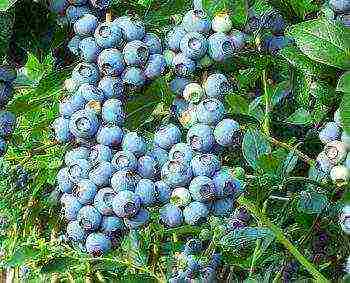
Blueberries are rich in vitamins and nutrients and are a valuable natural product.
Blueberry, regardless of its type and origin, is a light-loving plant; it prefers light loamy, peaty-sandy, fertile soil. Below we will consider a few of the main varieties of American tall blueberry that are highly resistant to frost and frost. Read also the article: → "Features of growing garden blueberries: the best varieties, planting methods, care."
Northern varieties of American tall blueberries
American and Canadian breeders have bred several hybrid varieties of tall blueberries, which are distinguished by high frost resistance, which have gained popularity in the middle lane and the Moscow region. Consider the main characteristics of the northern varieties of tall blueberries:
- "Rankokas" - the plant reaches a height of up to 2 m, due to the intensive formation of shoots, this type of blueberry is prone to thickening. Harvesting is carried out in mid-August, the yield is up to 5-6 kg from one bush. Berries on fruit clusters adhere tightly to each other, large up to 22 mm. They are characterized by rich aroma and sweet taste. This variety is the most frost-resistant and disease-resistant, characterized by excessive fruiting.
- "Bluecrop" - plant height up to 1.9 - 2 m. Erect shrub, shoots directed upwards. The fruiting clusters are elongated, the berries are free on the clusters. The fruits are large, from 16 to 20 mm in diameter, with a blue bloom, the shape of the berry is slightly flattened. Differs in high yield - up to 10 kg from one bush.
- "Dixie" is a powerful and spreading bush, reaching a height of 2 m. The berries are large, up to 22 mm, densely located on the fruit cluster. Productivity up to 7-8 kg from one bush. The shape of the berries is slightly flattened. The fruits begin to ripen in mid-August. The taste of the berries is sweet and sour, there is no aroma.
Dixie variety is resistant to moniliosis, brown rot and berry mummification
- "Blurei" is a spreading and erect shrub. Differs in intensive growth of shoots, reaches up to 1.5 - 1.8 m. The berries are large, 20-22 mm in diameter. Abundant fruiting, 6-7 kg per bush. The berries are located on the fruitful cluster tightly to each other. Harvesting starts from late July to mid-August. Needs pruning.
- "Patriot" is an upright plant variety, the height of the bush is 2m. The berries are densely collected on the fruiting brush, differ in a slightly flattened shape and of different sizes. Fruits reach 20 mm in diameter. The berries are fully ripe in the second half of July.
The above types of tall blueberries are early and mid-season varieties. In central Russia, they begin to bloom at the end of May. Fruiting later, the berries ripen in late July to mid-August.
The size and number of fruits directly depends on the proper care of the plants. The main advantage of the northern varieties is the quick recovery of frozen bushes. The table shows the maximum values of the low temperature for each variety during the period of frost and persistent frost.
| Name | Variety type | Frost resistance | Spring frost resistance |
| "Rankokas" | Early ripe | up to - 35 ° C | up to - 5 ° C |
| "Blukrop" | Mid-season | up to - 35 ° C | down to -7 ° C |
| "Dixie" | Mid-season | up to - 35 ° C | up to - 7 ° C |
| "Blue Ray" | Early ripe | up to - 34 ° C | up to - 5 ° C |
| "Patriot" | Early ripe | up to - 29 ° C | to - 3 ° C |
Domestic varieties of garden blueberries for cultivation in Siberia and the Urals
Variety Patriot is resistant to mummification of berries, gray mold
In the Central Siberian Garden, which is located in Novosibirsk, scientists have bred several frost-resistant blueberry varieties. The new varieties are able to withstand temperatures down to -42 ° C -45 ° C. There are 5 main blueberry varieties:
- Blue scattering - marsh blueberry, late ripening variety. Plant height up to 1 m. Fruit-bearing clusters are short, 4-5 berries are formed on each cluster. Berries have a sweet and sour taste, oval shape. Average yield up to 2 kg from 1 bush.
- The taiga beauty is a mid-season plant variety. The plant is vigorous, differs in sprawling long branches. Fruit-bearing racemes are elongated. The berries are large, dense. The berries are flattened. The taste is sour rather than sweet, with a bright aroma.
- Shegar blueberry is a medium-sized plant with a late ripening period. Plant height up to 50 cm. The crown of the plant is rare, the branches are slightly spreading. Differs in the simultaneous ripening of fruits. The berries are large, have a non-standard oval shape. The taste is sweet and sour, delicate. The yield is high up to 1.5 kg per bush.
- Yurkovskaya blueberry is a vigorous plant, up to 1.5 m tall. Erect branches, medium fruiting brushes. The crown of the plant is rare. The berries are very large, round in shape. They have a sweet and sour taste similar to that of grapes. The fruits ripen at the same time. Average yield - 1 kg per bush.
- Iksin blueberry is a medium-sized plant, up to 70 cm tall. The crown is rare, the branches are spreading. Fruiting clusters are small. The berries are large, round in shape, the edges are visible on the berries. The taste is sweet and sour. Average yield - up to 0.8-0.9 kg per bush.
The above varieties were bred by domestic breeders. All varieties were included in the State Register. The main requirement is that it is recommended to grow on peaty-sandy soils. Read also the article: → "Features of soil fertilization with peat."
Garden blueberry care
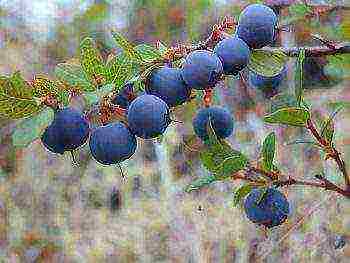
Garden blueberry Taiga beauty resistant to diseases
Blueberries need proper watering. The plant must be watered 2 times within 5-6 days. For each bush, 10-15 liters of water should be allocated. Watering is best done in the early morning or after sunset. Lack of moisture during fruiting affects the quantity and quality of the future crop. On the hottest days, the bushes of the plant should not only be watered, but also sprayed. This procedure is carried out in the morning or in the evening.
Tip # 1. To obtain a rich harvest, the plants must be pruned 2 times a year. The first pruning of the bush is carried out in the spring before the buds appear, the second - in the fall.
Pruning is also possible in the summer, if dry branches or diseased shoots have formed. Correct and timely pruning will form a strong skeleton, thanks to which the plant can withstand the severity of the harvest. Blueberry varieties with erect branches are thinned out only in the middle of the bush. In spreading bushes, branches are cut off that are in contact with the ground. See also the article: → "Blueberry pruning methods to increase yields."
Fertilizing blueberries to increase yields
To increase the yield and improve the growth of blueberries, it is necessary to properly feed. The plant is fed in spring 2 times. The first feeding is carried out during the period of swelling of the kidneys, the second feeding is carried out after 2 months. Blueberries are fed in the second year after planting.
By the appearance of the plant, you can determine the lack of certain elements.In the table, we will consider the main signs of a plant, indicating a deficiency of minerals.
| Mineral deficiency | External signs | |
| Minimum | Maximum | |
| Nitrogen | Shoot growth slows down or stops altogether | The bush turns yellow, the leaves become reddish-brown, the yield decreases |
| Phosphorus | Leaves curl, adhere to the stem | Curled leaves take on a purple hue |
| Potassium | Leaves develop spots | Shoots die off or turn black |
| Calcium | Leaves curl, turn yellow at the edges | Leaves die off |
| Magnesium | Leaves at the edges take on a reddish tint | — |
| Boron | The upper part of the leaves takes on a bluish tint | The growth of shoots stops, the leaves die off |
| Sulfur | Leaves acquire a yellowish-white bloom | Leaves turn white, die off |
The signs indicated in the table will make it possible to timely determine the shortage of certain elements and replenish on the basis of appropriate fertilizers. To increase the yield of blueberries, it is necessary to exclude feeding with organic fertilizers during the flowering and fruiting period.Read also the article: → "5 different fertilizers and fertilizers for blueberries for different types of soils".
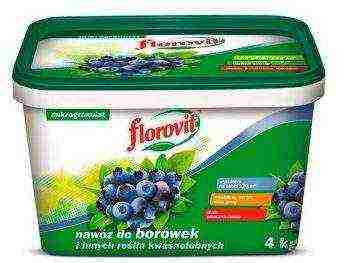
Multicomponent mineral soil fertilizer intended for feeding blueberries
Review of popular brands of fertilizers that increase blueberry yields
It is known that blueberries are not particularly demanding on the fertility of the land, but the yield directly depends on the quality of the fertilizers applied. Fertilizers are recommended to be applied in early spring, since during this period there is an active swelling of the buds and sap flow.
Tip # 2. For high yields of blueberries, it is recommended to apply nitrogen fertilizers in mid-May and mid-June. Superphosphates are best applied in summer and late autumn.
Experienced gardeners believe that the best fertilizer for blueberries is a mineral fertilizer containing ammonium sulfate, potassium sulfate and superphosphates. These substances are easily absorbed by blueberries. The table shows the main brands of fertilizers that are best absorbed by blueberries.
| Fertilizer brand | Compound | Mode of application | Advantages |
|
"Dunamis" |
A universal fertilizer containing an active biocatalyst containing all the necessary macro- and microelements. The main composition is manure and manure mixture with biological additives. | Fertilizer is applied at 10 g to the planting holes. After application, abundant watering is required | Increases productivity up to 35%, improves the taste of berries. Optimizes the water balance of the soil. Forms immunity to pathogenic diseases. Helps strengthen plant cells and maintain cell integrity. |
|
Bon Forte |
The main component is Zeolite, which is able to selectively absorb nutrients. | The granules are placed in the planting wells. After application does not require watering. It is recommended to add with peat in a ratio of 10 g of granules per 1 kg of peat. | The main purpose is to stimulate the formation of ovaries, to increase the yield of blueberries.
Optimizes water balance, aerates the soil, accumulates the most important components for the plant. Not washed out by rain, groundwater |
|
Florovit |
The main components are superphosphates, ammonium sulfate and potassium sulfate. | The granules are introduced into the planting holes. After application, abundant watering is required. For each plant 10-15 g. | Stabilizes the alkaline balance of the soil. Promotes plant development and increased fruiting. |
| Floritist |
The main components are ammonium and potassium sulfate. |
Mix with soil before planting 10 g per plant | The main property is to acidify the soil. Used on soils with low pH levels. The granules contain long-soluble substances, which prevents earlier leaching from the soil.
Promotes plant development and increased fruiting. |
Frequently asked questions when growing blueberries

It is worth noting that Bon Forte fertilizer is applied 2 times a year, the maximum dosage should not exceed 15 g per bush.
Question number 1. Can blueberries be planted next to trees or tall plants?
It is known that blueberries are light-loving and heat-loving plants. Planting blueberries in the shade of trees and shrubs is not recommended as the berries will be small and sour and the yield is low.
Question number 2. What is the best soil to grow blueberries?
Blueberries prefer acidic soil, peaty and light loamy soils.
Question number 3. Should I fertilize the soil with organic matter before planting blueberries?
Any organic fertilizer is capable of alkalizing the soil. Therefore, you should not add fertilizer before planting. It is enough to drain the soil and create an acidic substrate. To acidify the soil, 50 g of sulfur is added to the planting pits, mixed with river sand and peat in equal amounts. To acidify the soil, you can use a citric acid solution - 6-7 tsp for 20 liters of water. acid.
Question number 4. Is it possible to plant seedlings in open ground using the transshipment method?
It is best to buy seedlings with closed roots. Usually the seedlings are sold in special containers. It is not recommended to transplant the seedlings from the container into the planting hole when planting, since the formed clod of earth on the roots will not allow the tender roots of blueberries to develop. The container with the seedling should be immersed in water for a few minutes before planting, which will remove the clod of earth and spread the roots of the seedling before planting.
Question number 5. When can you prune blueberry bushes?
The bush should be cut in early spring before the buds swell. It is not recommended to prune a young bush. The bush is pruned 5-6 years after planting, when the yield decreases and the berries become small.
Common mistakes when choosing blueberry varieties
Breeders highlight several mistakes that they often make when choosing blueberry varieties:
- For planting in Siberia and the Urals, American tall blueberry varieties are chosen.
- Gardeners awaiting harvest in late August choose early and mid-season blueberry varieties.
- In regions with severe frosts, blueberry varieties are chosen that are characterized by uneven ripening.
Rate the quality of the article. We want to be better for you:
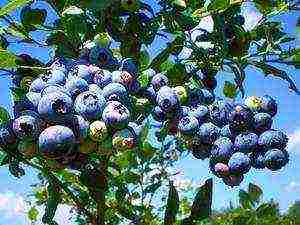 In the summer, each of us tries to replenish our body with vitamins, minerals and other useful substances for the whole year. The taste of summer is the taste of wild strawberry, strawberry, blueberry, blueberry, blackberry. The markets are overflowing with these berries and you can fully enjoy their unique taste and aroma.
In the summer, each of us tries to replenish our body with vitamins, minerals and other useful substances for the whole year. The taste of summer is the taste of wild strawberry, strawberry, blueberry, blueberry, blackberry. The markets are overflowing with these berries and you can fully enjoy their unique taste and aroma.
For blueberries and strawberries, you will have to go to the forest. But blueberries, which are a close relative of blueberries and belong to the heather family, can be planted on your site and collected a good harvest throughout the summer.
Blueberries - tasty and healthy
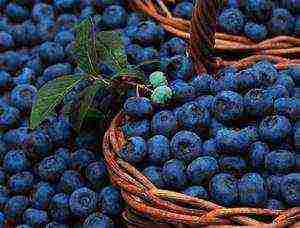 The main reasons why the berry is bred in summer cottages is its medicinal qualities. As for the taste, here it loses a little to blueberries, but the size of the fruits resembles more ripe cherries.
The main reasons why the berry is bred in summer cottages is its medicinal qualities. As for the taste, here it loses a little to blueberries, but the size of the fruits resembles more ripe cherries.
Useful properties of berries consist in hypoallergenic properties, the ability to strengthen the walls of blood vessels, normalize digestion, and have a positive effect on the state of the visual apparatus. Blueberries contain antioxidants and vitamins, as well as fiber that cleanses the intestines.
In appearance, the branchy bushes of the plant resemble blueberries. Usually their height does not exceed 50 cm, but there are varieties whose height can reach three meters. Blueberries are unpretentious, durable, resistant to diseases and pests. The yield of a crop depends on the variety. It can be improved by cross-pollination. From one bush harvested from 1.5 to 10 kg. The first fruits appear 3-4 years after planting.
Blueberry varieties
When characterizing a certain variety, attention is paid to the requirement for the conditions, the size of the berries and the preferred yield.The best varieties include those that, under optimal climatic conditions, allow you to get the maximum amount of tasty and large berries.
The most popular blueberry varieties
When choosing a variety, you need to refer to indicators such as:
- expected harvest volume;
- the size and appearance of the berries;
- taste;
- frost resistance;
- requirement for climatic conditions;
- the life of the bushes;
- resistance to pests and diseases.
All blueberry varieties are divided into two main groups: undersized and tall. There are also northern, southern tall and medium-sized varieties, as well as varieties of the rabbit eye subgroup.
Stunted blueberries
The most popular varieties for cultivation in our regions are considered to be varieties of low-growing blueberries, which are distinguished by high frost resistance.
-
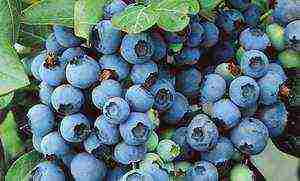 Notreblue... The culture is a low-growing bush, the height of which does not exceed 0.9 meters. The harvest period begins in August. From one bush, you can collect from 1.2 to 2.5 kg of dense dark blue, large berries with a good taste, which are stored raw for a long time. Delicious and healthy fresh berries. Also, blueberries can be used for processing, making jams, jams, juices from them, or you can simply freeze them for the winter. The variety can withstand frosts up to 35 degrees. Bushes can additionally perform a decorative function on the site.
Notreblue... The culture is a low-growing bush, the height of which does not exceed 0.9 meters. The harvest period begins in August. From one bush, you can collect from 1.2 to 2.5 kg of dense dark blue, large berries with a good taste, which are stored raw for a long time. Delicious and healthy fresh berries. Also, blueberries can be used for processing, making jams, jams, juices from them, or you can simply freeze them for the winter. The variety can withstand frosts up to 35 degrees. Bushes can additionally perform a decorative function on the site. - Notrcantree... Powerful undersized bush with a short growing season. Already in mid-July, the berries begin to ripen. Up to two kilograms of berries are harvested from one bush. The fruits are sweet, light blue in color, of medium size. The variety is not afraid of frost, therefore, it is suitable for growing in the northern zones. It is also appreciated for its decorative qualities.
- Chippewa... The height of the bushes varies on average from 80 to 100 cm. Light blue, large berries ripen early, have an excellent sweet taste, which allows them to be used for making pies, preserves, jams, jellies and other delicacies. Like the previous ones, this variety is frost-resistant, easily tolerates severe winters, withstanding frosts up to 30 degrees with a minus sign.
- Notland... A low-growing, powerful and spreading bush, the average height of which is about one meter. The variety is early, the fruits begin to ripen in mid-July. Regular good harvest - up to 8 kg per bush. Dense, blue, medium-sized berries have a pleasant sweet taste, are well stored and are excellent for making compotes, jams, preserves, jellies. This blueberry variety is quite frost-resistant, suitable for growing in the northern regions. A compact sprawling low bush will harmoniously decorate the landscape of the territory in which it grows.
- Bluegold... The variety was brought into mass production in 1988. The height of semi-spreading bushes does not exceed 120 cm. The fruits are sweet-sour, ripen quickly and quickly, after which they crumble. Mechanized harvesting is not recommended. Berries in the right conditions are stored for a long period. To prevent overloading of the branches, thinning and pruning are carried out. The blueberry variety is resistant to low temperatures, withstands up to 34 degrees with a minus sign.
Tall blueberry
Blueberry varieties of this group are not suitable for cultivation in cold and frosty winters, but they have a number of advantages. The yield can reach up to 10 kg from one bush. Berries of tall varieties are larger and sweeter.
-
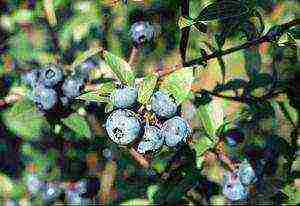 Bluecrop... One of the best representatives of both his group and culture in general. Known since 1941. The height of an erect, vigorous bush ranges from 160 to 200 cm. 4–9 kg of berries are harvested from one bush. The plant withstands a lack of moisture, adapts to any soil. In areas with high humidity it grows poorly, easily susceptible to shoot diseases. Light blue fruits are medium to large in size, slightly tart in taste.
Bluecrop... One of the best representatives of both his group and culture in general. Known since 1941. The height of an erect, vigorous bush ranges from 160 to 200 cm. 4–9 kg of berries are harvested from one bush. The plant withstands a lack of moisture, adapts to any soil. In areas with high humidity it grows poorly, easily susceptible to shoot diseases. Light blue fruits are medium to large in size, slightly tart in taste. - Berkeley... The height of a sprawling, vigorous bush can reach 2.1 meters. The variety can be identified by its large, light green leaves.Bushes reproduce easily, they are able to withstand frost. Harvesting begins in the second half of August. The fruits are rather large (up to 18 mm in diameter), light blue with a small scar. The berries are sweet, but difficult to store and transport. The plant tolerates temperature extremes well, does not require special care, and is used as a hedge.
- Elliot... The bushes of the plant are erect, vigorous, their height reaches two meters. Fruits are light blue with a small perianth. The ripening period begins in mid-September and ends in October. Fresh medium-sized berries can be stored for up to 12 weeks. You can improve yields by pruning the bushes. The variety does not like cold, damp areas, withstands frosts.
- Spartan... The height of a vigorous upright bush is up to 2 meters. The variety has been known in production since 1977. The ripening period begins in the second half of July. From one bush, from 4.6 to 6 kg of large, dense berries of a light blue hue are harvested, which are well transported and amenable to long-term storage. The taste of the berries is sour, the aroma is delicate and pleasant. Fresh fruit is recommended. The variety is not afraid of such diseases as mummification of berries, dying off of branches.
- Brigitte Blue... The variety is late. The bush of the plant reaches a height of 2 meters. The first berries begin to ripen in mid-August. From one bush, they collect from 4 to 6 kilograms. The berries are strong enough, light blue in color, up to 15 mm in diameter, taste sweet and sour. The variety is characterized by uniform ripening of fruits that do not crumble, are well transported and stored.
Medium blueberry
The varieties of this group are also known as semi-tall. Plants are skillfully bred for cultivation in the northern regions, as some representatives are able to withstand temperatures up to 40 degrees below zero.
-
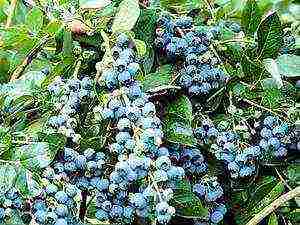 Patriot... It is one of the more popular blueberry varieties. The bushes grow quite quickly, their height does not exceed 1.5 meters. Their external difference is the sparse raised branches. The berries are very tasty and aromatic, with a dense skin, firm, flat, large, light blue. The ripening period lasts from July to August. This blueberry variety is recognized by many gardeners, due to its high yield, because up to 7 kg of berries are harvested from one bush. The plant is resistant to frost and common diseases.
Patriot... It is one of the more popular blueberry varieties. The bushes grow quite quickly, their height does not exceed 1.5 meters. Their external difference is the sparse raised branches. The berries are very tasty and aromatic, with a dense skin, firm, flat, large, light blue. The ripening period lasts from July to August. This blueberry variety is recognized by many gardeners, due to its high yield, because up to 7 kg of berries are harvested from one bush. The plant is resistant to frost and common diseases. - Duke... One of the best crop varieties. The height of an erect, vigorous bush ranges from 1.5 to 1.8 meters. Differs in a stable and high yield, ripens quickly and amicably, therefore, the collection, preferably manual, is carried out in 2-3 receptions. Light blue fruits are pleasant to the taste, sweetish-sour, sometimes slightly tart. The storage and transportability of the berries is relatively good. Early ripening is combined with late flowering to prevent damage to blueberries by spring frosts. The variety is frost-resistant, but grows very poorly in cold and damp areas.
- Chandler... The bushes reach a height of 1.5 meters, they are highly branched, fast-growing, erect. This blueberry variety is distinguished by large, blue, dense berries, the diameter of which reaches 20 mm, high and regular yield. The ripening period begins in August and lasts until mid-September.
Planting and leaving
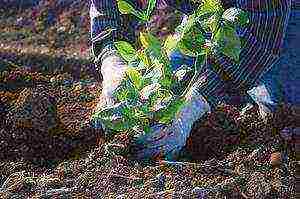 Blueberry yield depends on the growing conditions and care for it. The plant loves sunny places, sheltered from the wind, peaty, acidic soils. Blueberry roots go 30 cm deep. To provide the plant with the necessary substances, you can use soil from a pine forest with compost and deciduous humus.
Blueberry yield depends on the growing conditions and care for it. The plant loves sunny places, sheltered from the wind, peaty, acidic soils. Blueberry roots go 30 cm deep. To provide the plant with the necessary substances, you can use soil from a pine forest with compost and deciduous humus.
You can't feed the soil under blueberries with alkaline fertilizers (manure, humus, wood ash). Planting time is late autumn or early spring. The distance between the bushes depends on the type of blueberry.For undersized people it is 60 cm, for tall ones - 1–1.5 meters. After planting, it is recommended to mulch the land around the bushes with peat, sawdust or pine needles.
For propagation of blueberries, seeds, cuttings or cuttings are used. The last method is considered the most reliable. Lignified cuttings harvested in the fall are suitable here. When propagated by seeds, the first crop can be obtained in four years.
In order for blueberries to regularly produce generous crops, it is necessary to periodically feed the soil underneath. The plant does not need organic fertilizers, therefore, mainly mineral fertilizers are used - superphosphate, zinc, potassium, ammonium sulfate.
Blueberries need water regularlyespecially in hot weather. But, it is worth remembering that excess moisture can lead to a lack of air in the roots, as a result of which the plant will die. Low-growing varieties are watered only in dry, hot and not rainy summers. As a rule, they have enough natural moisture. Tall varieties are more in need of watering. To improve the condition of blueberries, the soil should be periodically loosened and mulched. In addition, the crop must be trimmed and cleaned, which is done in the fall after harvest or in the spring before the start of the growing season.
It is very important to choose the right blueberry variety, the choice of which depends on the local climate. So, in regions with cold, harsh winters, frost-resistant undersized or medium-sized varieties are planted. For regions with mild climates, any blueberry variety is suitable.
Blueberries in the garden are a very good solution. The culture is not picky and undemanding, it bears fruit well and can perform a decorative function. Blueberries are delicious, juicy and healthy. They contain a huge amount of vitamins and antioxidants, which have a positive effect on the health of the whole body. Blueberries are eaten raw and are recommended for people who suffer from vision problems. The fruits can be used to prepare preparations for the winter - preserves, jellies, jams, canning in their own juice. Blueberries keep well in the freezer and in cold winters will be a great find that will remind you of the taste of summer.
